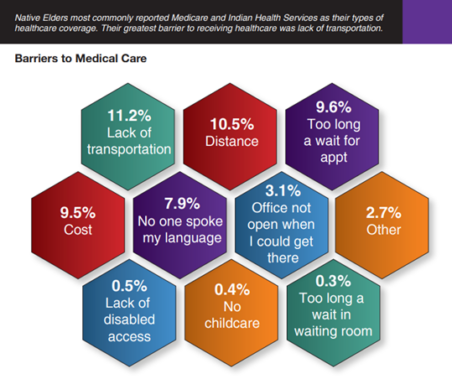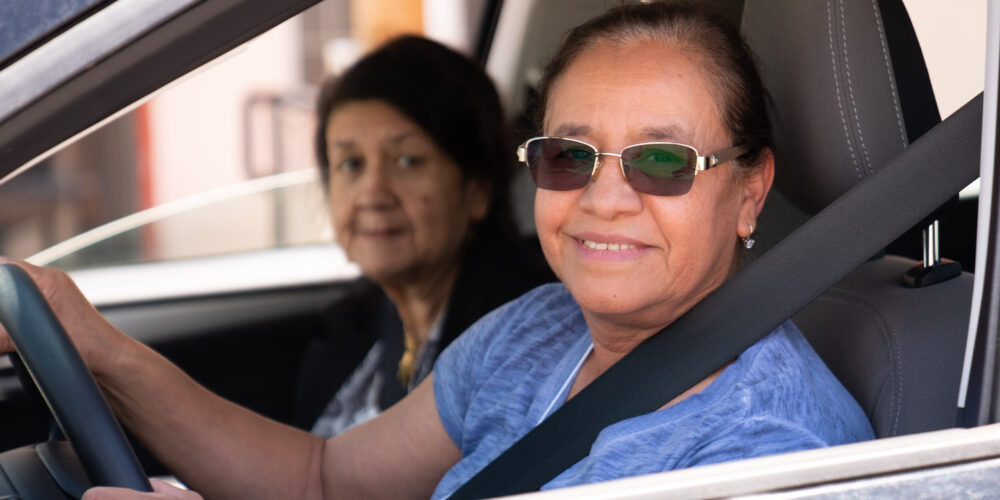The National Resource Center on Native American Aging (NRCNAA) was funded through a cooperative agreement by the Administration on Aging (AoA) in 1994. The center is operated by the University of North Dakota’s Center for Rural Health. Through a variety of educational resources, training and technical assistance provided, the center is focused on supporting the quality of life and assisting the Native American aging population. In addition to the main resource center, two other centers were established; the National Resource Center for American Indian, Alaska Native and Native Hawaiian Elders opened in Anchorage, Alaska; and in 2006 Hā Kūpuna (National Resource Center for Native Hawaiian Elders) opened in Honolulu, Hawaii
Across the U.S., tribal elder populations in many areas are left with little to no access to resources such as healthcare, food, housing, transportation, and social establishments. It is important for the resources to be accessible within the elder’s community while maintaining their cultural values embedded within their lifestyle. Extensive research has been conducted producing data that demonstrates the need for mobility options and showing the impact of health based on the lack of access.
Data
According to the Title VI Needs Assessment Survey: Identifying Our Needs: A Survey of Elders Cycle VII (2017-2020) the following data emphasizes the importance of the access to transportation in Native American communities as it demonstrates the how barriers can contribute to the inequities among communities. Without proper access to healthcare, life spans can be shortened.

Map Courtesy of National Resource Center on Native American Aging (NRCNAA)
- One in three Native American elders are disabled
- Lack of transportation was listed as the number one barrier (11.2%)
- Among those surveyed with 5 or more chronic health conditions reported lack of transportation due to the lengthy distance to access healthcare was a barrier (19.9%)
- 58.1% of those surveyed have high blood pressure with arthritis and diabetes
- 33.7% of Native elder Veteran’s surveyed were disabled
- 35.5 % of the elders surveyed stated they would use transportation in their area if offered
A huge barrier for Native American Elders in communities is infrastructure and transportation to resources to maintain a high quality of life. A tool called the Native Elder Service Locator provides an interactive map to assist with finding services for tribal elders in your state. This interactive map (detailed maps shown below) allows one to not only find vital services such as food pantries and healthcare, but also transportation to these services.
We know that there is a lack of knowledge among some in the transportation field on how to provide technical assistance or resources regarding universal mobility for tribal communities. Transit agencies, non-profit organizations, medical facilities can use the Native Elder Service Locator to develop partnerships with tribal transportation providers in their communities to assist with connecting the first and last mile options or to fill in where there are gaps in mobility to access healthcare appointments. Visit National Resource Center on Native American Aging (NRCNAA) to explore further to find transportations for the tribal elders and those with disabilities.

Map Courtesy of National Resource Center on Native American Aging
Other helpful resources hosted by the Center include the following:
Needs Assessment Surveys
This survey tools helps communities, tribes, and villages collect valuable data to track and document the health and social needs of elders. Data produced from the survey can be used for grant funding applications, community partnership meetings with stakeholders and dialogue among tribal elders. The survey results also meet the Title VI nutrition and caregiving grants required by the Administration on Community Living (ACL) awards.
The following services are provided free of charge to participating organizations:
- Preparing the needs assessment survey
- Scanning the surveys
- Cleaning data with statistical software
- Data analysis
- Modeling the data
The National Resource Center on Native American Aging (NRCNAA) provides data to the participating organizations once the analysis is completed.
Grant Writing
Grant writing training assists program managers and coordinators with how to seek out funding opportunities, collaborate with partners, write grants and perform evaluations.
Conclusion
The Native Elder Service Locator presents an opportunity to connect and learn about tribal transportation and figure out how to assist the elders best to meet their needs. As a program manager, this locator can be helpful connect other professionals and non-tribal organizations that may not have the services to support their nearby tribal residents or Native communities. The Native Elder Service Locator can be a valuable resource to support to your work.

Leave a Reply